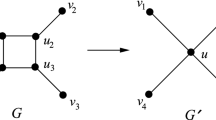Abstract
LetA=(a ij ) be the distance matrix of an arbitrary (asymmetric) traveling salesman problem and let τ=τ1τ2...τ m be the optimal solution of the corresponding assignment problem with the subtours τ=τ1τ2...τ m . By choosing (m−1) transpositions (k, l) withk ∈ τ i−1,l ∈ τ i (i=2, ...,m) and patching the subtours by using these transpositions in any order, we get a set of cyclic permutations. It will be shown that within this set of cyclic permutations a tour with minimum distance can be found by O(n 2|τ|* operations, where |τ|* is the maximum number of nodes in a subtour of τ. Moreover, applying this result to the case whenA=(a ij ) is a permuted distribution matrix (Monge-matrix) and thepatching graph G τ is a multipath, a result of Gaikov can be improved: By combining the above theory with a result of Park alinear algorithm for finding an optimal TSP solution can be derived, provided τ is already known.
Zusammenfassung
Es sieA=(a ij ) die Entfernungsmatrix eines (asymmetrischen) Rundreiseproblems und τ=τ1τ2...τ m die Optimallösung des zugehörigen Zuordnungsproblems mit den Teilzyklen τ=τ1τ2...τ m . Wählt man (m−1) Transpositionen (k, l) mitk ∈ τ i−1,l ∈ τ i (i=2, ...,m) und verknüpft man die Teilzyklen unter Zuhilfenahme dieser Transpositionen in beliebiger Ordnung, so erhält man eine Menge zyklischer Permutationen. Es wird gezeigt, daß man die kürzeste Tour in dieser Menge von Rundreisen mit einem Rechenaufwand von O(n 2|τ|* Operationen bestimmen kann, wobei |τ|* die maximale Anzahl von Städten in einem Teilzyklus von τ ist. Im Falle, daß die EntfernungsmatrixA=(a ij ) eine permutierte Verteilungsmatrix (Monge-Matrix) und der VerknüpfungsgraphG τ ein mehrfacher Weg ist, kann ein Resultat von Gaikov verbessert werden. In Verbindung mit einem Resultat von Park führt die oben entwickelte Theorie in diesem Fall zu einemlinearen Verfahren zur Bestimmung einer optimalen Rundreise.
Similar content being viewed by others
References
Aggarwal, A., Klawe, M. M., Moran, S., Shor, P., Wilber, R.: Geometric applications of a matrix-searching algorithm. Algorithmica2, 195–208 (1978).
Bhat, K. V. S.: The optimum assignments and a new heuristic approach for the traveling salesman problem. Inform. Sciences27, 121–132 (1992).
Burdyuk, V. Ya., Trofimov, V. N.: Generalization of the results of Gilmore and Gomory on the solution of the traveling salesman problem (in Russian). Izv. Akad. Nauk SASS, Tech. Kibernet.3, 16–22 (1976) [Translation: Engineering Cybernetics14, 12–18 (1976)].
Carlier, J., Villon, P.: A new heuristic for the travelling salesman problem. Recherche opérationelle (RAIRO)24, 245–253 (1990).
Deineko, V. G.: Applying a dynamic programming to solving a special traveling salesmen problem (in Russian). Issledovanie operaziy i ASU, Kiev 14, 47–50 (1979).
Deineko, V. G., Filonenko, V. L.: On the reconstruction of specially structured matrices (in Russian). Aktualnye problemy EVMi programmirovanie, Dnepropetrovsk, DGU, 43–45 (1979).
Eppstein, D.: Sequence comparison with mixed convex and concave costs. J. Algorithms11, 85–101 (1990).
Gaikov, N. E.: On the minimization of linear form on cycles (in Russian). Vestsi Akad. Navuk BSSR Ser. Fiz.-Mat. Navuk4, 128 (1980).
Gilmore, P. C., Gomory, R. E.: Sequencing a one state variable machine: a solvable case of the travelling salesman problem. Oper. Res.12, 655–679 (1964).
Gilmore, P. C., Lawler, E. L., Shmoys, D. B.: Well solved special cases. Chapter 4 in [13].
Karp, R. M.: A patching algorithm for nonsymmetric traveling salesman problem. SIAM J. Comput.8, 561–573 (1979).
Klyaus, P. S.: Generation of test problems for the traveling salesman problem (in Russian), unpublished manuscript [Preprint No. 16, Inst. Mat. AN BSSR, Minsk], (1976).
Lawler, E. L., Lenstra, J. K., Rinnooy Kan, A. H. G., Shmoys, D. B.: The traveling salesman problem. Chichester: Wiley, 1985.
Park, J. K.: A special case of then-vertex traveling salesman problem that can be solved inO(n) time. Inform. Process. Lett.40, 247–254 (1991).
Sarvanov, V. I.: On quadratic choice problems (in Russian). Ph.D. Thesis, Inst. Mat. AN BSSR, Minsk (1978).
Sarvanov, V. I.: On the complexity of minimizing a linear form on a set of cyclic permutations (in Russian). Dokl. AN SSSR253, 533–535 (1980) [Translation: Soviet Math. Dokl. 22, 118–120].
Author information
Authors and Affiliations
Rights and permissions
About this article
Cite this article
Burkard, R.E., Deineko, V.G. Polynomially solvable cases of the traveling salesman problem and a new exponential neighborhood. Computing 54, 191–211 (1995). https://doi.org/10.1007/BF02253612
Received:
Issue Date:
DOI: https://doi.org/10.1007/BF02253612




